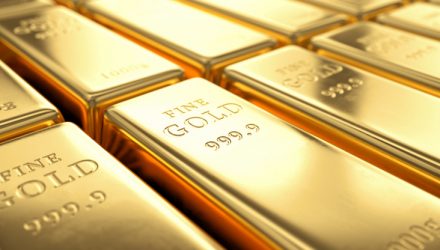Investors who are interested in diversifying their portfolio with a gold-related ETF should consider the drivers behind gold’s recent performance and some of the potential growing benefits of incorporating gold in a portfolio mix of traditional stocks and bonds.
On the recent webcast, Why Gold is Shining Bright This Quarter, George Milling–Stanley, Chief Gold Strategist, State Street Global Advisors; and Juan Carlos Artigas, Director, Investment Research, World Gold Council, explained how gold has shined in today’s volatile market as global monetary policies shifted and economic risks heightened.
Gold has enjoyed a number of positive tailwinds. As the global PMI weakened over the past year, gold has strengthened on increased demand for safety to hedge against slowing growth concerns. A shift to lower rates, and even negative yields in some global developed economies, has contributed to increased demand for physical gold to safe guard wealth.
Beyond the short-term shifts, the precious metal is also characterized as a long-term, a strategic asset. Since 1971, gold has exhibited a 7.87% compound annual growth rate. The yellow metal has improved a portfolio diversification with low correlated returns to traditional stocks and bonds – gold has demonstrated a -0.01 and 0.07 monthly correlation to the S&P 500 Index and Bloomberg Barclays US Aggregated Bond Index, respectively, since the 1970s. Additionally, gold may potentially improve risk-adjusted returns and provide some protection against unexpected events, both macroeconomic and geopolitical.
The strategists pointed out that allocating a portion of gold in place of stocks and bonds could have helped investors enhance returns and even diminish drawdowns. Looking at hypothetical blended portfolio performances based on historical data of the constituents of the hypothetical portfolios between January 1, 2005 to June 30, 2019, they found that a portfolio without gold exposure showed lower annualized returns and a lower Sharpe ratio, or weaker risk-adjusted return, when compared to the same portfolios with allocations with 2%, 5% or 10% gold exposures.
Examining gold demand
Looking at gold demand, jewelry accounts for the greatest portion at 49% of total demand, followed by investments 27%, central banks 17% and technology 7%. Year-over-year, central banks contributed to a 57% increase in gold demand while investments showed a 2% rise and jewelry exhibited a 1% positive change, whereas technology demand slipped 2%. The spike in central bank demand may not be too surprising given the shift to looser monetary policies and even negative rates.
Looking ahead, the strategists highlighted four major drivers of gold, including: Economic expansion or periods of growth historically have been supportive of jewelry, technology and long-term savings. Risk and uncertainty or market downturns historically have boosted the price of gold. Opportunity cost or the price of competing assets such as bonds (through interest rates), currencies and other assets, may influence investor attitudes towards gold. Lastly, momentum or capital flows, positioning and price trends may support or dampen gold’s performance. Economic expansion and risk and uncertainty are more strategic drivers while opportunity cost and momentum may be seen as more tactical drivers.
While some investors may have include some gold exposure through a broader diversified commodity fund, the amount of gold exposure may be negligible or not enough. For instance, the Bloomberg Commodity Index has a 12% allocation to gold, S&P GSCI Index allocates 4% to gold and the Rogers International Commodity Index has 5% in gold. Gold has outperformed many broad-based commodity idnices and nearly all individual commodities over the past two decades.
As a way to diversify a traditional stock and bond portfolio, Milling–Stanley highlighted a number of gold-related ETF strategies, including the SPDR Gold Shares (NYSEArca: GLD) and SPDR Gold MiniShares Trust (NYSEArca: GLDM).
GLD is the largest and most heavily traded gold ETF, offering strategic, long-term investors relatively low entry and rebalancing costs, plus robust optionality.
GLDM is designed to offer the potential benefits of a long-term, strategic allocation to gold — for less. With an expense ratio of just 18 basis points, GLDM offers the pure buy and hold investor a lower share price and lower holding costs.

